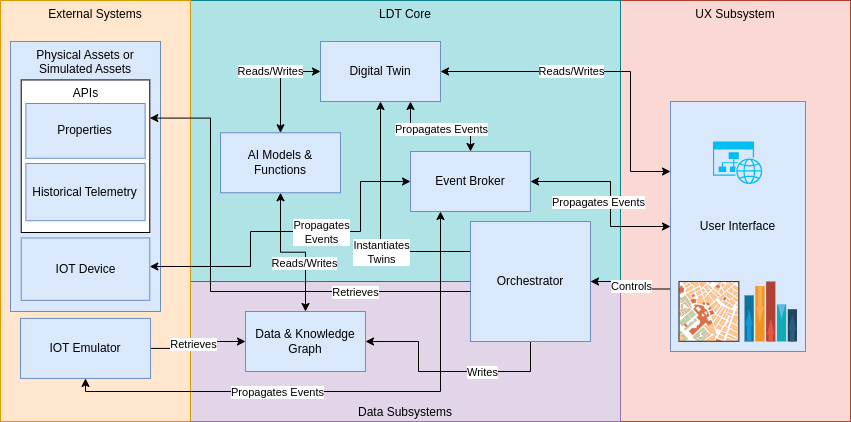by Noé Marius, Patrick Gratz, Laurence Johannsen, and German Castignani (Luxembourg Institute of Science and Technology)
The deployment of electromobility in urban areas is crucial for sustainable development. Local Digital Twins (LDTs) are especially relevant to monitor, predict and simulate the potential of electromobility as well as process renewable energy scenarios to support the development of smart, sustainable and ultimately net-zero cities.
In the context of the European Testing and Experimentation Facilities (TEF), the CitCom.ai project [L1] focuses on smart cities and communities, emphasising mobility, connectivity and power-related topics. CitCom.ai provides topical TEFs where AI innovators create scalable AI-powered services for smart cities. The Luxembourg TEF specifically focuses on electromobility and its impact on urban mobility [1].
Cities and communities face challenges in deploying electromobility, particularly in the strategic placement of charging stations and ensuring energy capacity. Locating chargers requires considering multiple parameters: accessibility, demand, and grid infrastructure, balancing user convenience with minimal disruption. Poorly positioned chargers can lead to range anxiety (i.e. the driver’s fear that their EV won’t have sufficient charge to reach their destination) and underutilisation. Ensuring sufficient renewable energy capacity involves investing in renewable infrastructure or collaborating with energy operators to upgrade the grid as loads increase, manage peak demand, and integrate renewable sources.
As part of the Luxembourg TEF, we conduct a pilot experimentation of a LDT toolbox for electromobility planning, designed however to be replicable and scalable to different cities, topics and datasets. LDTs emerge indeed as powerful tools for city planners to make informed decisions, by creating dynamic, real-time virtual replicas of cities, allowing for precise planning and management of urban systems, such as electric vehicle (EV) infrastructure or renewable energy generation. LDTs integrate various data sources, including built environments and real-time telemetries (e.g. IoT, energy consumption), and can incorporate relevant demand and supply models for electromobility along with smart visualisation tools. In a first instantiation of our LDT toolbox, we collaborate with Differdange, a Luxemburgish city well-known for its industrial heritage and green spaces, committed to sustainability and actively pursuing net-zero carbon emissions through innovative urban planning, renewable energy initiatives, and eco-friendly transportation solutions.
Working with the city’s energy and mobility experts, we developed an initial LDT architecture to model electromobility challenges, including charging points, buildings and solar patches. This architecture includes data collection and telemetry emulators, spatio-temporal and graph databases, DT cloud solutions, and smart maps and dashboards. We considered relevant city data, including current charging positions, load curves and energy consumption. Several models were derived from this data and integrated into the LDT; they are leveraged to produce synthetic telemetry and predictive telemetry depending on the parameters of a simulation.
As defined by Rasheed et al. [2], “a digital twin can be defined as a virtual representation of a physical asset enabled through data and simulators for real-time prediction, optimisation, monitoring, controlling, and improved decision making”. Our digital twin toolbox comprises a set of off-the-shelf and custom-made technological building blocks that allows us to represent the physical assets as digital twins. Once instantiated the twins become live entities. We can interact with them either as a collection of twins or individually, monitor their statuses, predict, optimise, or even control the real physical asset if it is an IoT Device. The key features of the toolbox are:
- Orchestrator: Manages different pipelines to gather entities and triggers the generation of telemetry data from models if necessary.
- Handles Diverse Telemetry Sources: Enables interaction with real-time telemetry, collection of historical data, or generation of synthetic telemetry based on models for each entity.
- IoT Emulator: Emulates IoT devices and plays historical or synthetic data.
- AI Models: We can plug in AI models to produce predictive telemetry, optimise performance, perform real-time monitoring, run simulations, and support decision making.
As shown on the high-level architecture diagram (Figure 1), we can populate on demand our digital twin with relevant entities based on a geocoordinate bounding box and date. The entities’ models come from twin meta-models based on the NGSI-LD ontology developed for smart cities. During provisioning, the orchestrator triggers data pipelines to retrieve entities (physical assets or simulated ones) and store relevant telemetry data from models built by domain experts, AI models, or real datasets. Each entity is then instantiated in our Dynamic Digital Twin, where it can have its own interfaces and trigger events based on its properties and telemetry. We can interact with the digital twins through APIs or the user interface to run “what-if” scenarios or send commands to IoT devices. Moreover, our goal is now to further explore different technologies. For instance, we aim to replace components like Microsoft’s Azure Digital Twin and the Digital Twins Definition Language (DTDL) based on the NGSI-LD ontology with other open-source solutions.

Figure 1: LDT high-level architecture diagram.
The pilot experimentation conducted through the project CitCom.ai shows the great potential of digital twins in terms of planning, simulation and prediction. It demonstrates that rapid experimentation in city-wide LDTs is possible, notably by allowing to:
- test and experiment with technologies to build a modular LDT architecture
- derive models to emulate telemetries in the digital twin
- collaborate with cities to understand their needs and leverage their data.
Beyond electromobility, we aim to expand the digital twin toolbox for various applications and for making them replicable. Future activities include refining the toolbox’s capabilities, enhancing scalability, and integrating more advanced AI models for predictive analytics. We will continue exploring technologies incrementally, and building a multipurpose tool for cities to connect data, models and services, following advancements in LDTs, AI and data analytics.
The project CitCom.ai is co-funded through the EU Digital Europe Programme, call “Cloud data & TEF, 2022”. The Luxembourg TEF is co-funded by the Luxembourg Ministry of Economy under an ERDF grant.
Link:
[L1] https://citcom.ai
References:
[1] European Commission, Net Zero Cities initiative.
[2] Rasheed et al., Digital Twin: Values, Challenges and Enablers from a Modeling Perspective, 2020.
Please contact:
Noé Marius, Patrick Gratz, Luxembourg Institute of Science and Technology, Luxembourg











